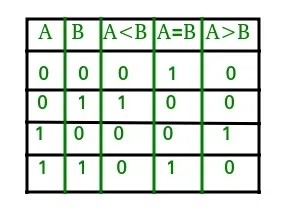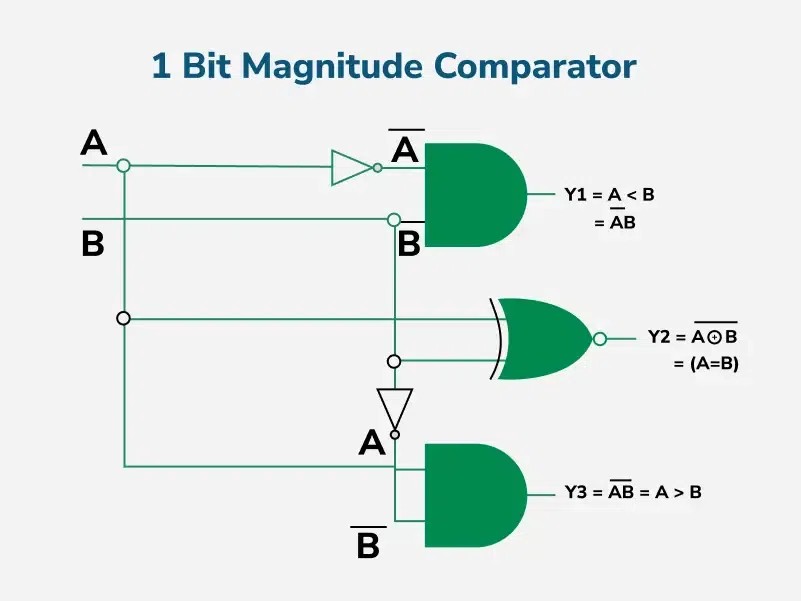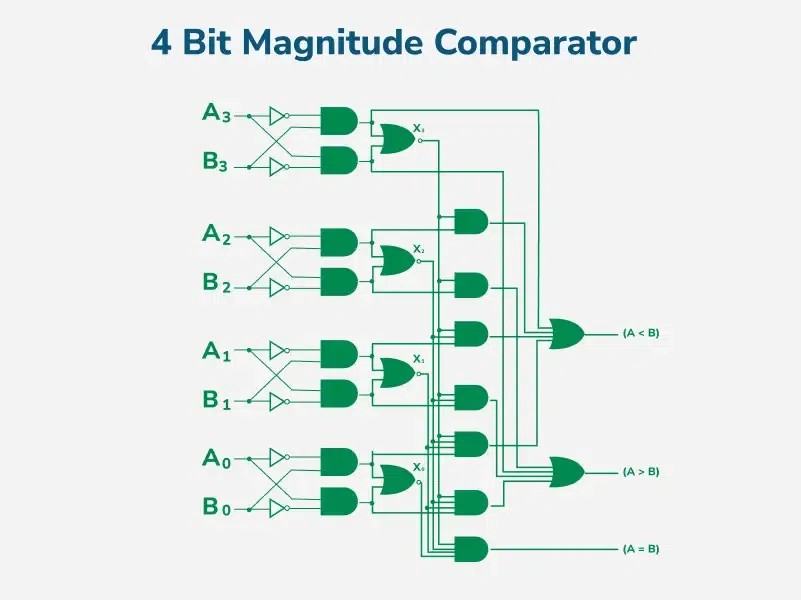Magnitude comparators are fundamental in digital electronics for comparing binary numbers. At COMPARE.EDU.VN, we offer comprehensive comparisons to simplify your understanding. This guide explores magnitude comparators, including their types, applications, advantages, and disadvantages, while also providing key insights into digital logic design. Explore the essentials for informed decision-making in digital systems and beyond. Discover valuable resources to enhance your knowledge and skills.
1. Understanding Magnitude Comparators
1.1. What is a Magnitude Comparator?
A magnitude comparator is a combinational circuit that compares two binary numbers to determine their relative magnitudes. Essentially, it decides whether one number is greater than, less than, or equal to the other. These comparators are essential components in various digital systems, including sorting networks and decision-making circuits, ensuring accurate numerical comparisons.
1.2. How Does a Magnitude Comparator Work?
The comparator operates by comparing the bits of the two input numbers, starting from the most significant bit (MSB) and moving towards the least significant bit (LSB). At each bit position, the corresponding bits of the numbers are compared. If a bit in the first number is greater than the corresponding bit in the second number, the A>B output is set to 1, indicating that the first number is greater. Conversely, if the bit in the second number is greater, the A0 output is set to 1.
1.3. Types of Magnitude Comparators
Magnitude comparators can be classified based on the number of bits they compare:
- 1-Bit Magnitude Comparator: Compares two single-bit numbers.
- 2-Bit Magnitude Comparator: Compares two 2-bit binary numbers.
- 4-Bit Magnitude Comparator: Compares two 4-bit binary numbers.
- N-Bit Magnitude Comparator: General comparator for N-bit numbers, often achieved by cascading smaller comparators.
2. 1-Bit Magnitude Comparator
2.1. What is a 1-Bit Magnitude Comparator?
A 1-bit magnitude comparator is the simplest type of comparator, used to compare two single-bit binary numbers. It has two inputs, one for each bit, and three outputs indicating whether the first bit is less than, equal to, or greater than the second bit.
2.2. Truth Table for a 1-Bit Magnitude Comparator
The truth table for a 1-bit comparator is as follows:
| Input A | Input B | Output A < B | Output A = B | Output A > B |
|---|---|---|---|---|
| 0 | 0 | 0 | 1 | 0 |
| 0 | 1 | 1 | 0 | 0 |
| 1 | 0 | 0 | 0 | 1 |
| 1 | 1 | 0 | 1 | 0 |




2.3. Logical Expressions for a 1-Bit Magnitude Comparator
Based on the truth table, the logical expressions for each output can be derived as follows:
- A > B: A * B’
- A < B: A’ * B
- A = B: A’ B’ + A B (which can also be expressed as A XNOR B)
2.4. Logic Circuit Implementation for a 1-Bit Magnitude Comparator
Using these Boolean expressions, the logic circuit for a 1-bit comparator can be implemented using AND, OR, and NOT gates. The circuit consists of:
- One AND gate for A > B (A * B’)
- One AND gate for A < B (A’ * B)
- One XNOR gate for A = B (A’ B’ + A B)
3. 2-Bit Magnitude Comparator
3.1. What is a 2-Bit Magnitude Comparator?
A 2-bit magnitude comparator compares two 2-bit binary numbers. It has four inputs (two bits for each number) and three outputs indicating whether the first number is less than, equal to, or greater than the second number.
3.2. Truth Table for a 2-Bit Magnitude Comparator
The truth table for a 2-bit comparator is as follows:
| A1 | A0 | B1 | B0 | A < B | A = B | A > B |
|---|---|---|---|---|---|---|
| 0 | 0 | 0 | 0 | 0 | 1 | 0 |
| 0 | 0 | 0 | 1 | 1 | 0 | 0 |
| 0 | 0 | 1 | 0 | 1 | 0 | 0 |
| 0 | 0 | 1 | 1 | 1 | 0 | 0 |
| 0 | 1 | 0 | 0 | 0 | 0 | 1 |
| 0 | 1 | 0 | 1 | 0 | 1 | 0 |
| 0 | 1 | 1 | 0 | 1 | 0 | 0 |
| 0 | 1 | 1 | 1 | 1 | 0 | 0 |
| 1 | 0 | 0 | 0 | 0 | 0 | 1 |
| 1 | 0 | 0 | 1 | 0 | 0 | 1 |
| 1 | 0 | 1 | 0 | 0 | 1 | 0 |
| 1 | 0 | 1 | 1 | 1 | 0 | 0 |
| 1 | 1 | 0 | 0 | 0 | 0 | 1 |
| 1 | 1 | 0 | 1 | 0 | 0 | 1 |
| 1 | 1 | 1 | 0 | 0 | 0 | 1 |
| 1 | 1 | 1 | 1 | 0 | 1 | 0 |
3.3. Logical Expressions for a 2-Bit Magnitude Comparator
Based on the truth table, the logical expressions for each output can be derived using Karnaugh maps (K-maps):
- A > B: A1 B1′ + (A1 XNOR B1) A0 * B0′
- A < B: A1′ B1 + (A1 XNOR B1) A0′ * B0
- A = B: (A1 XNOR B1) * (A0 XNOR B0)
3.4. Logic Circuit Implementation for a 2-Bit Magnitude Comparator
The logic circuit for a 2-bit comparator can be implemented using AND, OR, NOT, and XNOR gates, based on the derived Boolean expressions.
4. 4-Bit Magnitude Comparator
4.1. What is a 4-Bit Magnitude Comparator?
A 4-bit magnitude comparator compares two 4-bit binary numbers. It has eight inputs (four bits for each number) and three outputs indicating whether the first number is less than, equal to, or greater than the second number.
4.2. Conditions for Outputs in a 4-Bit Magnitude Comparator
For a 4-bit comparator:
- A > B:
- If A3 = 1 and B3 = 0
- If A3 = B3 and A2 = 1 and B2 = 0
- If A3 = B3, A2 = B2 and A1 = 1 and B1 = 0
- If A3 = B3, A2 = B2, A1 = B1 and A0 = 1 and B0 = 0
- A < B:
- If A3 = 0 and B3 = 1
- If A3 = B3 and A2 = 0 and B2 = 1
- If A3 = B3, A2 = B2 and A1 = 0 and B1 = 1
- If A3 = B3, A2 = B2, A1 = B1 and A0 = 0 and B0 = 1
- A = B: Only when all individual bits of one number exactly match the corresponding bits of the other number.
4.3. Logical Expressions for a 4-Bit Magnitude Comparator
Based on the conditions above, the logical expressions for each output can be expressed as follows:
- A > B: (A3 B3′) + ((A3 XNOR B3) (A2 B2′)) + ((A3 XNOR B3) (A2 XNOR B2) (A1 B1′)) + ((A3 XNOR B3) (A2 XNOR B2) (A1 XNOR B1) (A0 B0′))
- A < B: (A3′ B3) + ((A3 XNOR B3) (A2′ B2)) + ((A3 XNOR B3) (A2 XNOR B2) (A1′ B1)) + ((A3 XNOR B3) (A2 XNOR B2) (A1 XNOR B1) (A0′ B0))
- A = B: (A3 XNOR B3) (A2 XNOR B2) (A1 XNOR B1) * (A0 XNOR B0)
4.4. Logic Circuit Implementation for a 4-Bit Magnitude Comparator
The logic circuit for a 4-bit comparator can be implemented using AND, OR, NOT, and XNOR gates based on the derived Boolean expressions.
5. N-Bit Magnitude Comparator
5.1. Generalizing to N-Bit Comparators
For an n-bit comparator, the complexity increases significantly. The total number of combinations is 2^(2n). The number of equal combinations (A = B) is 2^n. The number of unequal combinations is 2^(2n) – 2^n. The number of greater (A > B) and less (A < B) combinations are equal, each being (2^(2n) – 2^n) / 2.
5.2. Cascading Comparators
To compare binary numbers with more than four bits, multiple 4-bit comparators can be cascaded. In this arrangement, the outputs of the lower-order comparator are connected to the corresponding inputs of the higher-order comparator.
6. Applications of Comparators
6.1. Use in CPUs and MCUs
Comparators are extensively used in central processing units (CPUs) and microcontrollers (MCUs) for performing comparison operations, which are crucial for decision-making and control.
6.2. Control Applications
In control applications, binary numbers representing physical variables such as temperature, position, etc., are compared with a reference value to maintain desired conditions.
6.3. Process Controllers and Servo Motor Control
Comparators are used in process controllers to maintain process parameters and in servo motor control systems to ensure accurate positioning.
6.4. Password Verification and Biometric Applications
Comparators are used in password verification systems to compare entered passwords with stored passwords and in biometric applications to compare scanned biometric data with stored data.
7. Advantages of Comparators
7.1. Simplicity and Efficiency
Comparators are simple and efficient for comparing binary values, making them suitable for various digital systems.
7.2. Fast Decision-Making
Comparators provide fast decision-making capabilities in digital circuits, essential for real-time applications.
7.3. Easy Integration
Comparators can be easily integrated into complex systems such as processors and arithmetic units, enhancing their functionality.
7.4. Modular Design
The modular design of comparators allows them to scale solutions for comparing multi-bit numbers by cascading smaller comparators.
8. Disadvantages of Comparators
8.1. Bit Limit for Comparison
Comparators have a limit on the number of bits they can compare efficiently, leading to increased complexity for larger bit comparisons.
8.2. Complexity for Large Bits
Implementing comparators for large bit numbers requires more complex circuitry, increasing the cost and size of the system.
8.3. Power Consumption
Power consumption increases with the complexity of the comparator circuit, especially for larger bit widths.
9. Conclusion
Magnitude comparators are essential in digital logic systems, enabling the comparison of binary numbers and playing a vital role in various applications. While simple and efficient for smaller bit widths, they become more challenging to manage with larger bit widths and power consumption. Understanding magnitude comparators is crucial for anyone working with digital systems and electronics.
10. FAQs About Magnitude Comparators
10.1. What is the primary function of a magnitude comparator?
The primary function of a magnitude comparator is to compare two binary numbers and determine whether one is greater than, less than, or equal to the other.
10.2. How many inputs and outputs does a 1-bit magnitude comparator have?
A 1-bit magnitude comparator has two inputs (one for each bit) and three outputs (A < B, A = B, A > B).
10.3. What is the difference between a 2-bit and a 4-bit magnitude comparator?
A 2-bit comparator compares two 2-bit binary numbers, while a 4-bit comparator compares two 4-bit binary numbers. The 4-bit comparator is more complex and can handle larger numbers directly.
10.4. How can comparators be used in control systems?
Comparators can be used in control systems to compare a physical variable (represented by a binary number) with a reference value, allowing the system to take corrective actions based on the comparison result.
10.5. What are the advantages of using comparators in digital systems?
Advantages include simplicity, efficiency, fast decision-making, easy integration into complex systems, and modular design for scalability.
10.6. What are the limitations of using comparators?
Limitations include bit limits for comparison, increased complexity for large bit comparisons, and increased power consumption with complexity.
10.7. How are magnitude comparators used in password verification?
In password verification, a magnitude comparator compares the entered password (converted to binary) with the stored password (also in binary) to verify their equality.
10.8. Can multiple 4-bit comparators be used to compare larger binary numbers?
Yes, multiple 4-bit comparators can be cascaded to compare larger binary numbers. The outputs of the lower-order comparator are connected to the corresponding inputs of the higher-order comparator.
10.9. What is the significance of the XNOR gate in magnitude comparators?
The XNOR gate is used to determine equality between bits. In comparators, XNOR gates are used to compare corresponding bits and determine if they are equal, which is crucial for determining overall equality between the numbers.
10.10. How does cascading comparators increase the capability to compare more bits?
Cascading comparators allows the comparison of more bits by combining multiple smaller comparators. The lower-order comparators determine the relationships between their bits, and their outputs feed into higher-order comparators to finalize the comparison for the entire number.
11. COMPARE.EDU.VN: Your Ultimate Comparison Resource
Are you struggling to compare different digital components and make informed decisions? At COMPARE.EDU.VN, we provide comprehensive and objective comparisons across a wide range of products, services, and concepts. Whether you’re evaluating magnitude comparators, digital logic circuits, or other technologies, our detailed analyses, pros and cons lists, and user reviews are designed to simplify your decision-making process.
11.1. Explore More at COMPARE.EDU.VN
Visit COMPARE.EDU.VN today to discover the best options tailored to your needs. Our platform offers a wealth of information, ensuring you have all the facts at your fingertips. From in-depth feature comparisons to expert opinions, COMPARE.EDU.VN is your go-to resource for making smart, confident choices.
11.2. Contact Us
For more information or assistance, please contact us at:
- Address: 333 Comparison Plaza, Choice City, CA 90210, United States
- WhatsApp: +1 (626) 555-9090
- Website: COMPARE.EDU.VN
Make the right choice with compare.edu.vn!
